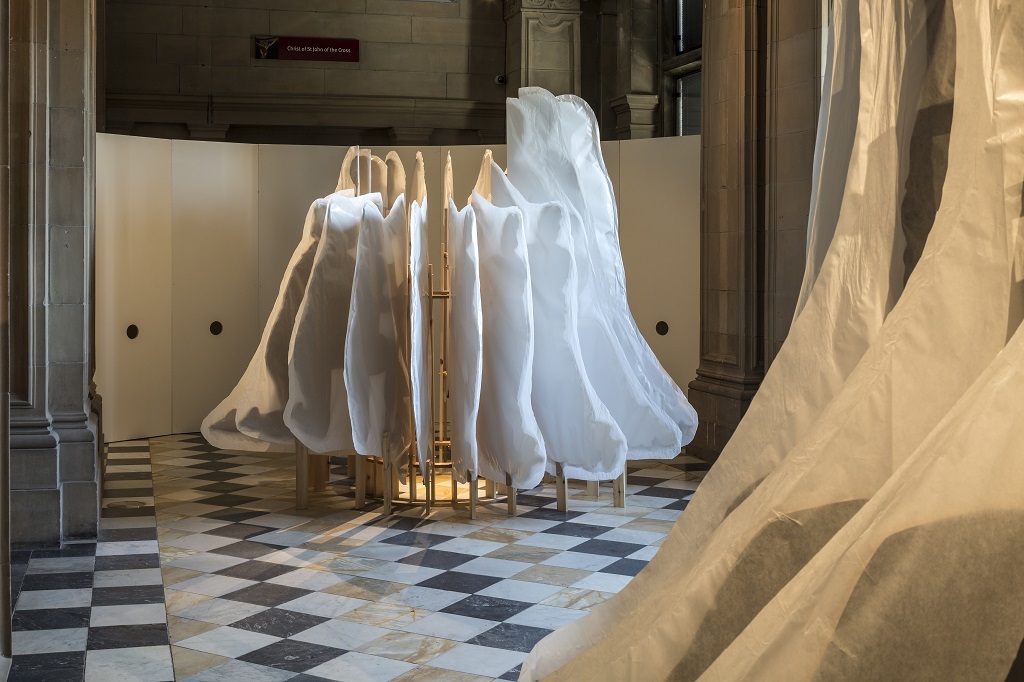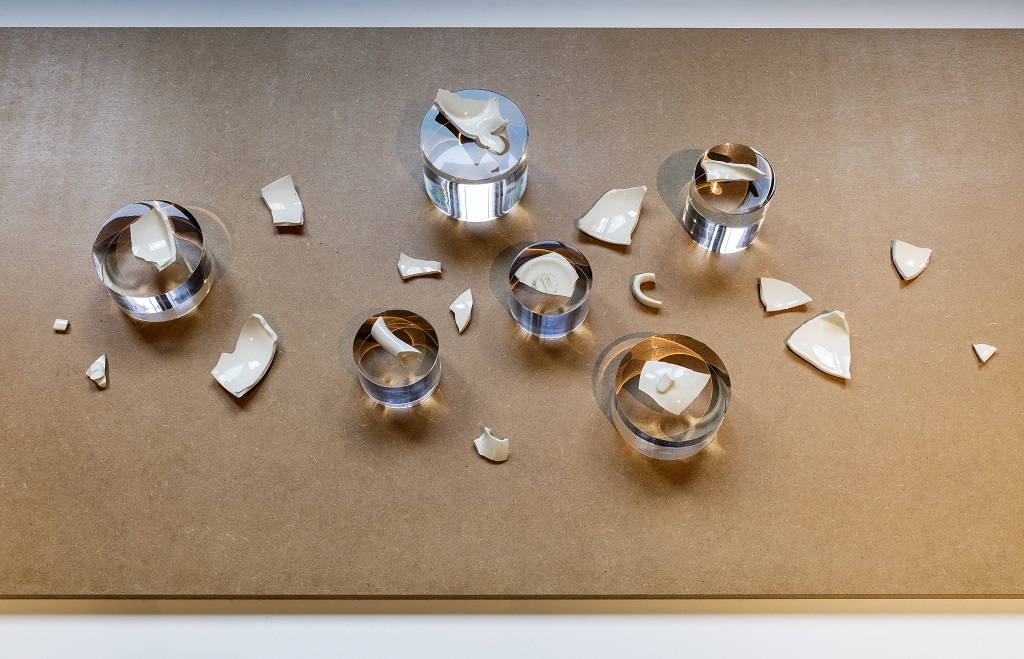
Thought-provoking art unveiled at Kelvingrove
A major new thought-provoking artwork, intended to stimulate critical reflection on the First World War, as well as on museum collecting and care, has been unveiled.
Kelvingrove Art Gallery and Museum, Glasgow, is hosting I Say Nothing, internationally renowned Scottish artist Christine Borland’s creative response to Glasgow Museums’ World War I collection.
The large-scale sculpture was co-commissioned with 14-18 NOW, the UK’s arts programme for the First World War centenary, and made possible through the generous support of Art Fund.
I Say Nothing confronts the dichotomy of institutional care and brutality by focusing on the historical use of invalid feeder cups, both to nurse wounded soldiers during World War I and to force-feed hunger-striking suffragettes in the years running up to 1914.
It is the culmination of a year-long research residency at Glasgow Museums Resource Centre. The final piece evolved and was informed by field trips to Flanders Belgium, other collections and war museums, a creative symposium, Doubtful Occasion, and a participatory PhotoSculpture event at Kelvingrove Art Gallery and Museum.
Using the little-known technique of photo-sculpture from the mid-19th century, the artist worked with models and participants to document two poses that represent the diametrically opposed ways in which the feeder cup was employed.

Christine Borland, I Say Nothing, Kelvingrove Art Gallery and Museum (Photo: Keith Hunter)
The resultant sculptures embrace all the inherent distortions and inaccuracies of the process to question the accuracy of representation and the power of a seemingly humble object.
Christine said: ‘The outcomes of this commission couldn’t have been anticipated when we began the project two years ago at GMRC. I am grateful to all the Glasgow Museums staff who have supported this long process and were willing to embrace the unknown, both in the research and development of the work.
‘My questions and requests, which in some cases challenged accepted practices and protocols, were met with thoughtful and encouraging responses and I’m thrilled to have been enabled to realise such an ambitious work.’
Chair of Glasgow Life, Councillor David McDonald, said: ‘I Say Nothing is a bold, thought-provoking contemporary artwork for Glasgow. It is a striking, powerful addition to the city’s art collection. The contradiction presented by the sculpture is certain to re-ignite interest in our World War I collection and stimulate debate and reflection on the nature and history of conflicts old and new.’
The World War I collection held by Glasgow Museums has grown significantly over the last 100 years to provide an extraordinarily rich and abundant resource and was the basis for the commission.
Throughout the year long research residency Christine Borland had full access to the city’s state of-the-art collection storage facility and archival resources at the celebrated Glasgow Museums Resource Centre and the Kelvin Hall, together with the public displays housed in the city’s nine civic museums. The artist was supported by art and history curators and conservators who made objects accessible for viewing.
One object held particular fascination, a simple white ceramic invalid feeder cup, which was an unaccessioned object in Glasgow Museums’ Open Museum World War I handling kit. This object became the lynchpin for the whole artwork.
Christine continued: ‘Feeder cups like this were widely used to nurse wounded soldiers during World War I, but also, perhaps surprisingly, to force-feed hunger-striking suffragettes in the period directly before 1914 – 1918. This duality intrigued me, as did the very tactile form of the cup itself, which is at once so personal and domestic in scale, yet institutional in function.’
As part of the commission, Borland travelled to Flanders Belgium where they still make safe World War I munitions. There the Open Museum invalid feeder cup was exploded in a controlled detonation. The fragments form part of the artwork. Transformed, these pieces make a profound statement about meaning, memorialisation and loss.
In exchange Borland gifted two similar invalid feeder cups to Glasgow Museums, one becoming part of the World War I handling kit and the other entering the collection as an accessioned object.

Christine Borland, I Say Nothing, Kelvingrove Art Gallery and Museum, 2018. Photograph © Keith Hunter.
I Say Nothing is one of three displays at Kelvingrove Art Gallery and Museum in 2018 to mark the 100th anniversary of the ending of World War I in November 2018.
Frank Brangwyn in World War I: Art in Aid of Blind Soldiers and Sailors, on show in the Fragile Art gallery, presents a series of five lithographic prints illustrating the experience of a soldier in World War I who went to war, was blinded on the battlefield, hospitalised and then supported to learn a new trade.
Brushes with War: Art from the Front Line is the European debut of a world-class temporary exhibition of 219 original paintings and drawings by the troops who served in World War I. Following a chronological narrative it portrays most major battles and all aspects of the First World War. Depicted in oils, watercolours and drawings the artworks were created by frontline soldiers from numerous countries from 1914 to 1918. It runs until 6 January 2019.
A further World War I commission by Christine Borland, to The Power of Twelve, is currently on display in Mount Stuart on the Isle of Bute until 18 November 2018, with an accompanying publication.
I Say Nothing is on display on the south balcony at Kelvingrove Art Gallery and Museum. It is free to view.
For more information visit www.glasgowmuseums.com. A full colour book accompanies the commission, Christine Borland I Say Nothing. It is available from Kelvingrove Museum’s gift shop, priced at £12.
TAGS

